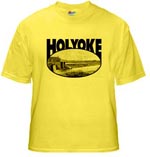by Laurel | March 21st, 2014
13 August 1899
Holyoke’s Old Portage Road
Early History of the River
Recalled by the Plan to Reopen the Road for Traffic
A careful study is now being made by the city engineering department of the old portage or “carry” road, running from a point near John Prew’s house in Springdale to a point on Northampton street near the new house of E. H. Friedrich. Much is obscure in regard to the establishment of this road, if indeed it ever was established. Perhaps its claim to existence will, after all on the old law of 20 years’ usage, rather than on surveys and layouts on record. In the early days land was of less consequence than it is today and the custom of using this part of land for portage purposes was apparently not objected to by the owners of the property and property adjacent, and would have continued, doubtless, until this day had not the traffic which supported it been diverted into other channels. It is of interest to recall the old days that this old and now abandoned highway conjures up as it still exists, fresh in the memories of the older men — Alexander Day Roswell Crafts, Oscar Ely and others, who can still see in imagination the broad country as it existed before the immense water-power that made Holyoke had been developed and rolls of iron had displaced sail and pole of the river craft.
In the early days much more use was made of the river than to-day. Flatboats manned by three or four men and carrying 25 or 30 tons began their journeys from Hartford up the river as soon as the ice broke out in the spring. For a long period of time the passage of the South Hadley rapids, upon which water-power the Holyoke dam was later to be built was not made by the boats. Landing was made a little way south of the Springdale trotting park and the goods hauled up through this road to a point near the foot of the hill going toward Smith’s Ferry, just beyond Kenilworth. Originally it is said that the road was formed by water washing down the sides of the gully. However this may be, it was so sandy that it made hard carrying. The farmers all around the region counted on this traffic as a considerable aid to their income. For the transportation to the boats in waiting Smiths Ferrywards they received $2 a ton. A full load could not be gotten up the sandy incline. If a teamster found himself at the Springdale landing alone, he would put on part of a load and haul it to Northampton street. He would then return and get the rest, and reloading his former half-load would jog merrily on toward the upper landing. More often, however, there would be two or more teams at the landing, in which cases the horses would be doubled and each in turn would have his load hauled to the top of the hill. Each pair of horses would then be attached to its own load and the journey toward Smiths Ferry begun. Concerning the goods carried, it is said boats going up carried a great variety of products, such as those who were unable to visit a great trading city were likely to purchase — textile goods, groceries, boots and shoes, hardware and the like. The boats on the return trip would carry big loads of maple sugar — Roswell Crafts remembers, in company with other urchin, of sampling maple sugar n the landing, in such unlawful ways as the small boy from time immemorial invents; broom — Alexander Day has seen many a boatload of brooms alone — and butter, cheese and perhaps lumber and farm products.
Hartford was in those days, as now, the head of navigation. The trip to the Holyoke landing would take from a day to two or three days, according to the wind and the weather. Alexander Day remembers coming up from Hartford with a strong favorable south wind in a single day. When wind favored their ride sails were put up and the passage was easy. When the wind was absent or unfavorable, the men had to pole along. If there were five men, four would pole and one would street. In the earliest times the Enfield rapids were a trouble to the navigators. Extra men were on duty at this point to help along the boats, two or three coming to each boat for their aid. In unfavorable times a half-day was consumed in making the five miles. In the ‘2o’s the canal was built first more for navigation than manufacturing purposes, and then passage was much easier. About 1830 a passage was opened on the east side of the South Hadley rapids and after a while boats were able to make the passage. This gradually ended the traffic over the portage road, and the construction of the railroad and the building of the dam ended it altogether. The landing-place fell into disuse and the road itself became nearly forgotten until the growing city, pushing its arms out Elmwood way and toward Springfield began to feel the need of a “short cut” between the places. Whether the growth of the city has yet been sufficient to warrant the expenditure of $3,000 or more to put this road into good traveling condition is a matter about which there may be two different opinions. The old deed that Assistant Engineer McCarthy has looked up seem to read, many of them, to the center of this highway. Oscar Ely remembers that there were two entrances to the highway, one north and one south. There seems to be some doubt as to the authenticity of some of the maps and surveys. But these will not affect the road itself, only the question of its exact location which doubtless can be approximated closely enough without injury to anyone.
From The Springfield Republican.









